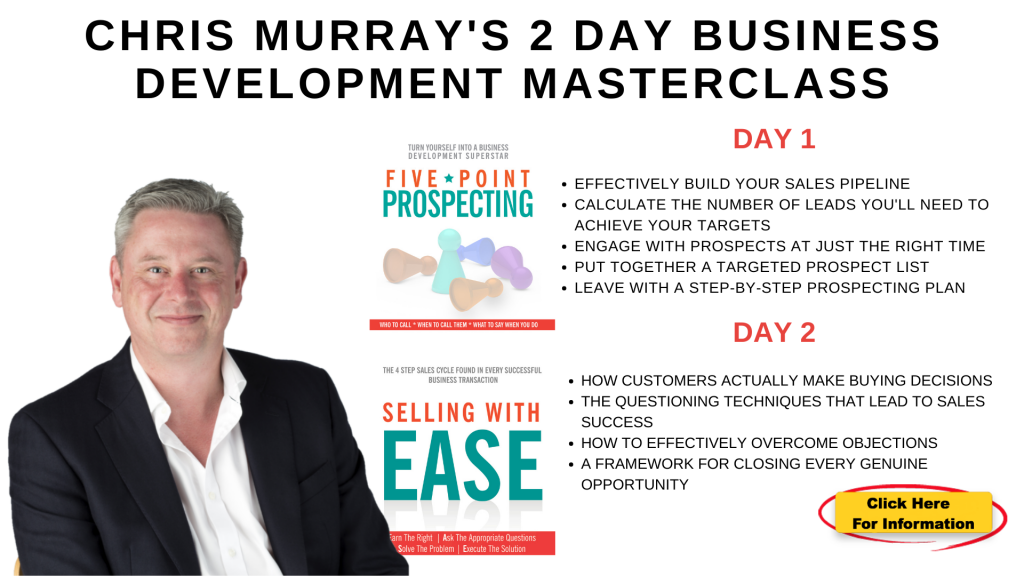The (Often Ignored) 3-Step Prospecting Strategy
If you want to put together an effective prospecting strategy, then there are three distinct groups that you need to be aware of before you start.
The 3 groups are:
* Oblivious
* Aware of Us – or
* Buy from Us
It might seem like common sense to many of you reading this, that there are certain sections of society who:
- have never heard of your business (not a thing),
- have a limited knowledge of what you do – or
- already buy stuff from your company
But if everybody is aware that those groups are distinctly different from one another, why is it that sales teams tend to have a single prospecting strategy or toolbox which they slap onto whatever kind of business development situation they find themselves in?
The ‘one strategy fits all’ approach is often why so many sales teams only ever achieve partial success.
You see, each of the groups above requires a completely different approach from the other, a different game plan, a different gameboard to play on. But once you’re aware of that fact, putting something in place that will actually work for you, becomes a whole lot easier.
Let me explain….
Oblivious People
First off, there are a group of prospects who are completely oblivious to what you do. These people have absolutely no idea how you can help them, or that you have helped other people just like them.
Sure, they may have seen some of your advertising in the trade press or passed a truck with your branding emblazoned all over it every now and again – but for one reason or another, they just don’t associate your logo with solving their problems, needs or requirements.
Now, it’s easy to believe that – when you’re sitting in your own commercial bubble, surrounded by colleagues, constantly bombarded with your own marketing message and rallied by the battle cries of your leadership team – that there are very few people who are oblivious to the things you do, how you do it and why you are so important to the marketplace.
In fact, I have worked in sales for a number of leadership teams, who would slap you down verbally in an internal meeting if you even slightly suggested that the company was anything lesser than their vision of a universally recognised example of commercial perfection.
There are a couple of brands in the world that have that level of recognition, but not many – and even those companies have offerings that some of their target market could benefit from – and yet still don’t.
The “oblivious” prospecting process usually requires more time, money and effort than the other two groups, and can be painfully slow for a sales team that is constantly being chased to hit its target.
So, leadership teams tend to throw a massive list at the sales team and then seek to manage output in volume and “busyness” – rather than opportunity creation or momentum.
Which is why we all get bombarded with generic emails and vacuous cold calls from those salespeople.
The four parts of the sales cycle matter just as much with this group as any other, and if you fail to earn the right, or worse – create a massive commitment gap before you’ve even started – then your success rates will always be low and your customer churn will be high.
Start from the understanding that these people are oblivious to us and – at this moment in time – we are complete strangers to them.
Not only do they not know what help you can offer them, some are oblivious to the fact that anybody can offer that help to them – anybody at all.
Therefore, the prospecting plan for the oblivious prospect is one of careful awakening and realisation.
An example of this approach is coined in a coaching phrase that I like, which says; ‘recognition is curative’.
Essentially, if you have your eyes opened to a particular roadblock, something that has been holding you back, but someone points you in the right direction to find its solution – then once you’ve recognised the problem exists, you work towards curing it yourself.
A shortcut for a regularly travelled route – one that saved you time and took miles off your current journey – would be something you’d want to know about. But until someone shows you the way, helped you recognise that there is a solution to your problem – you weren’t even aware you had a problem to begin with.
But now you do know, and every time you cut away from that long line of stationary traffic, you smile a self-satisfied smile and drive half the distance through a series of empty roads and lanes.
And that’s what we need to do with oblivious prospects. We enable them to recognise a problem while showing them how to come out the other side with the minimum amount of fuss.
Required Strategy
This is true and pure prospecting – and as such, we need to begin on the very first square of the prospecting gameboard.
Whittle your prospect list down so that it only consists of people who are most likely to need your product or service – and then further by eliminating any who fall below the average size of customer needed to help you hit your end of year target
(if you haven’t heard me speak about it previously, make sure you’re up to speed with the blue whale rule of prospecting – and work out how much time, money and effort will be required to convert this type of prospect into a paying customer – before you even start this process).
Once that work is done, you need to apply customer attraction techniques so that the prospect feels that they have discovered – rather than been hunted by – you.
This will allow you to earn the right to move forward far easier (and much quicker) than simply bombarding them with full on sales messages, links to adverts or your company’s generic marketing literature.
Aware of us
The people who don’t buy from you even though they are aware of who you are and what you do, fall into the middle, well-trodden ground of prospecting – and are often thought as easier wins than the oblivious prospect – but that simply isn’t true.
In some ways they are even harder to convert into paying customers, because they have actually made a conscious decision not to trade with you.
And for better or worse, it is where they now find themselves – and to have to change their mind would mean admitting to themselves (and others) that they had made a mistake with their previous choice.
Now, you might want to send these people a couple of well-meaning messages that will educate these lost, foolish souls.
Maybe you want to find a way of organising a little time in their diary so you can share your presentation about all the things they have been ignorant of in the past.
But if you do that, you’re almost certainly starting from the wrong place.
Why? Well, it’s because you’re failing to recognise the very thing that you’re working so hard to manoeuvre yourself around – and it’s this…
As far as your prospect is concerned, they have already found the solution to the problem that you are trying to help them with – or they have convinced themself that it isn’t bad enough to require any help from any external source.
So, the real questions we need to ask ourselves are:
What was it that our competition promised that made them take action and become their customer?
If they don’t already have a solution in place from anyone else, what information will help overcome their apathy and indifference?
Required Strategy
Once you have the answers to those two questions, you start on the very first square of the prospecting gameboard – but with a slightly different approach than you had for the oblivious people.
Selling directly at this point – or worse, trying to convince them that they shouldn’t have married someone that they’re perfectly happy with – will only be met with varying levels of negativity and barrier building.
You need to earn the right by becoming a trusted voice and helpful adviser. Use the ‘test the water’ and ‘raise your hand’ squares on the prospecting gameboard to fully understand what it is they need, and work out how they feel about their current situation – enabling them to recognise their own saudade – and then approach you for the best advice on how best to move forward.
Buy from us
I guess the title of this group is fairly self-explanatory, but just to be clear, this group is populated by those who are currently purchasing products or services from you, or at least have done so within a timeframe that still places them in the ‘that’s one of our existing customers’ box.
Business development in this sense has usually got more to do with brand extensions, cross-selling or new product development, and so can also be seen as a form of strategic account management rather than sales prospecting.
However, not all businesses have a regularly re-ordered product that just gets ‘topped up’ when it runs out. There are some products, services and circumstances that take you back to the beginning of the gameboard after a certain timeframe.
On other occasions, there might be accounts where a particular department, office or depot buys from us on a regular basis – but countless opportunities are waiting for us is other areas of the customer’s business.
I once worked with a colleague who worked closely with his contact on the first floor of a company situated in a large office block. After three months of introductions and referrals, he had signed even larger contracts on the second, third, fifth and eighth floors too – exceeding his annual target with a single account.
Required Strategy
The business development strategy for this group of prospects is made up of just that – referrals, testimonials, well-crafted introductory messages and elements of proof.
But beware of taking them for granted or approaching the opportunity with a laissez-faire attitude or a mass mail out just because “we’ve already got them”.
Use the Ear, Fear and Clear contact model to explore all available opportunities and treat each new contact with reverence and respect of a brand new prospect.
****************************************************
Interested in finding out more?
London | Manchester | Glasgow | Birmingham
(click on preferred city for full details)


